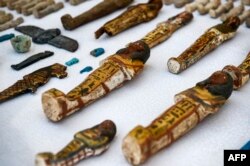
[ad_1]
Egypt on Saturday unveiled an ancient grave, sarcophagi and burial objects discovered in the Theban Necropolis of Al-Assasif, near the city of Luxor in the south of the country.
At a ceremony in front of the temple of Queen Hatshepsut, the Minister of Antiquities, Khaled al-Anani, announced that French and Egyptian archaeologists had discovered "a new grave … with very beautiful paintings".
Located between the royal tombs of the Valley of the Queens and the Valley of the Kings, the necropolis of Al-Assasif is the burial place of nobles and high officials close to the pharaohs.
Among the finds in the tomb are sarcophagi, statues and about 1,000 funerary figurines called "Ushabti" in wood, faience and clay.
The tomb dates from the middle kingdom, which extended to the eleventh and twelfth dynasties, and belonged to the supervisor of the mummification "Thaw-Irkhet-If" at Mut's temple in Karnak, according to the ministry.
In addition, archaeologists from the French Institute of Oriental Archeology and the University of Strasbourg have discovered two sarcophagi dating from the eighteenth dynasty, said Anani at a conference of press.
One of the two contains the "well-preserved" mummified remains of a woman named Thuya, the Ministry of Antiquities announced in a statement.
However, spokeswoman Nevine Aref told AFP that experts were still trying to identify the name of the mummy.
The Egyptian authorities regularly announce archaeological discoveries with great fanfare, although the country is often accused of lack of scientific rigor and neglect of its antiquities.
Archaeological sites, especially in Luxor, make Egypt a major attraction for foreign tourists.
Struck by the turmoil that enveloped Egypt after the 2011 uprising that overthrew longtime president, Hosni Mubarak, the tourism sector has resumed vigor this year.
